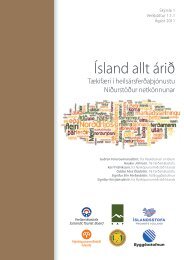Untitled
Untitled
Untitled
You also want an ePaper? Increase the reach of your titles
YUMPU automatically turns print PDFs into web optimized ePapers that Google loves.
do so on the basis of its own specific relative geographical location and the<br />
specific accessibility this allows for.<br />
Globalisation, as the word itself suggests, points to the whole globe.<br />
Behind notions of a free-floating, de-materialised global tourism market,<br />
where prices are set between supply and demand, there is always a<br />
material tourism geography of specific nodes and routes that connects and<br />
disconnects places as tourist destinations on the Earth. Although New York<br />
may be marketed as a “global city” this does not mean that it exists or<br />
reaches everywhere. New York, like all other places on the Earth, is strictly<br />
local too. Yet, due to its relative position in a wider network of<br />
transportation, communication, economics and politics, it can indeed have<br />
a strong influence on other places.<br />
There are then reasons, not least geographical, to be cautious and not<br />
take the level of the global for granted. It may well be adequate to use the<br />
concept globalisation as denoting horizontal processes and highlighting an<br />
increasing interconnectedness of the world, but what one finds behind are<br />
networked local places and events. These do not float around as locals in a<br />
global container space, but exist through their relative positional<br />
connectivity. As Thrift points out, global space:<br />
is no longer seen as a nested hierarchy moving from ‘global’ to ‘local’.<br />
This absurd scale-dependent notion is replaced by the notion that what<br />
counts is connectivity (Thrift 2004, p. 59).<br />
Contrary to those popular notions and expressions claiming that “the<br />
local and the global are related” to each other, or that “they influence each<br />
other” in various ways, the local and the global are then not to be<br />
conceptualised as two separate entities. In the same vein, this equally<br />
applies to the relationship between tourism and the global. As Urry writes<br />
when arguing for a hybrid conceptualisation of tourism and the global:<br />
There are not two separate entities, the ´global´ and ´tourism´ bearing<br />
some external connections with each other. Rather they are part and<br />
parcel of the same set of complex and interconnected processes.<br />
Moreover, such assembled infrastructures, flows of images and of<br />
people, and the emerging practices of ´tourist reflexivity´ should be<br />
conceptualised as a ´global hybrid´. It is hybrid because it is made up of<br />
an assemblage of technologies, texts, images, social practices and so on,<br />
that together enable it to expand and to reproduce itself across the globe<br />
(Urry 1990/2002 p. 144).<br />
68
















